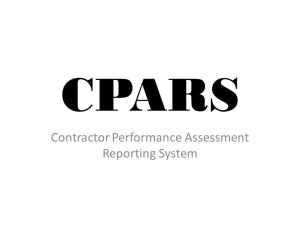
Why CPARS Ratings Matter: An Appeal for Fair and Accurate Evaluations
In the world of federal contracting, past performance isn’t just a line item—it’s currency. For small businesses and large firms alike, a strong CPARS (Contractor Performance Assessment Reporting System) rating can be the deciding factor between winning and losing a new contract. Yet, despite the critical importance of these ratings, contractors are often met with a familiar refrain: “You did great—but we gave you ‘Satisfactory’ because we don’t do anything higher.”
That approach is not only discouraging—it’s damaging.
CPARS: More Than Just a Report Card
CPARS is the government’s formal mechanism for recording how well a contractor performed on a given contract. It covers key areas like quality, schedule, cost control, management, and regulatory compliance. These evaluations are then fed into the Past Performance Information Retrieval System (PPIRS), where source selection officials use them to assess risk when reviewing new proposals.
According to the most recent guidance for the Contractor Performance Assessment Reporting System from this year, “Source selection officials rely on clear and timely evaluations of contractor performance to make informed business decisions when awarding government contracts and orders. This information is critical to ensuring that the Federal government only does business with companies that provide quality products and services in support of the agency’s missions.” https://www.cpars.gov/cparsweb/assets/documents/CPARS-Guidance.pdf
Put simply: CPARS ratings follow us.
They shape our ability to compete for future work. They’re reviewed by contracting officers, program managers, and acquisition officials who have never met us—but who will make award decisions based in part on these ratings. A consistent stream of “Satisfactory” evaluations, even if the work exceeded expectations, can hinder a contractor’s ability to demonstrate a competitive edge.
The Cost of Playing It Safe
We understand that contracting officers are busy, and that “Satisfactory” can feel like the safest, lowest-risk rating to assign—especially when there’s no formal complaint and the work was completed as expected. But if a contractor went above and beyond, delivered early, solved complex problems, or provided exceptional customer service, a “Satisfactory” rating becomes a misrepresentation.
Federal contractors don’t just want good ratings for the sake of a gold star—we need them to compete. Many solicitations require offerors to have multiple “Very Good” or “Exceptional” CPARS ratings in relevant work. If those ratings don’t reflect the true performance simply because it’s not common practice to give them, it creates a cycle of missed opportunity and misaligned incentives.
As laid out in the most recent CPARS guidance, it is “important for the information reported to include current, accurate, and complete statements about the contractor’s performance because this information will be used to assist, inform, and influence future source selection and award decisions.” When evaluations default to “Satisfactory” despite clearly exceeded expectations, they undermine the intent of the CPARS system—to support thoughtful, performance-based acquisition decisions that reward excellence and mitigate risk.
A Call for Thoughtful Evaluation
We encourage our government partners to:
- Rate based on actual performance. Did the contractor exceed expectations? Deliver faster than required? Resolve challenges with minimal oversight? These are the hallmarks of “Very Good” and “Exceptional” ratings—not just “Satisfactory.”
- Provide narrative detail. The written portion of CPARS is just as important as the numerical scores. A thoughtful explanation of the contractor’s strengths (or areas for improvement) helps paint a complete picture.
- Recognize CPARS as a critical performance currency. These ratings impact not just the past contract, but a contractor’s entire future with the federal government.
CPARS was designed to create transparency and accountability in federal contracting. But for it to work, it must reflect the reality of performance—not just the comfort zone of “meets requirements.” Accurate, honest, and thoughtful ratings benefit everyone in the acquisition ecosystem. They reward high-performing contractors, support better procurement decisions, and ultimately help agencies meet their mission with the best partners at their side.

A leader in providing strategic solutions to the federal government, Contemporaries was founded in 1991 and continues to provide streamlined, expert services to federal agencies. As a Woman-Owned Small Business, we consistently leverage our experience and expertise to anticipate our clients needs and advance their critical programs, realizing the maximum productivity and peak performance for every individual and project. At Contemporaries, every employee, contractor, and client is a part of the family, and for us, family comes first.
Contemporaries, Inc.
UEI:NBVYYCY9ATK5
CAGE: 1CHR5
NIH BPA: 75N98023A00010
NIH LTASC: 75N98023D00023
OASIS+ WOSB Contract: # 47QRCA24DW350
OASIS+ Small Business Contract: #47QRCA24DW350
GSA MAS Admin and Professional Support Schedule: 47QREA23D000F
Contact us at: 301-565-0445 or at info@contemps.com
We accept government credit cards.
